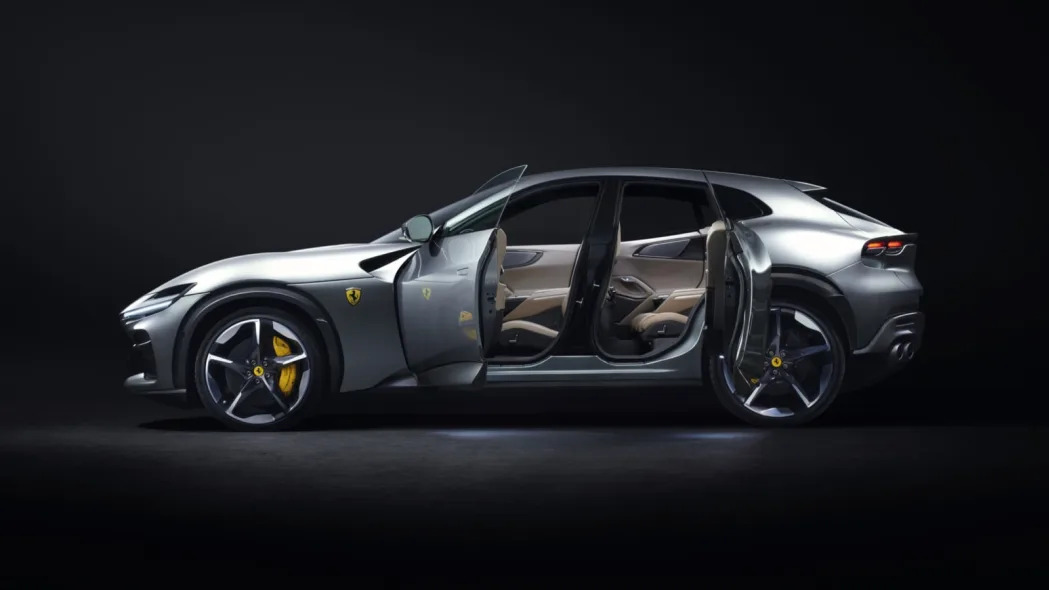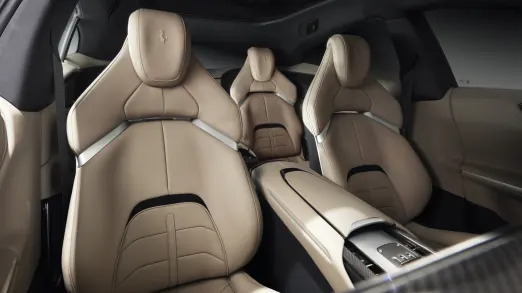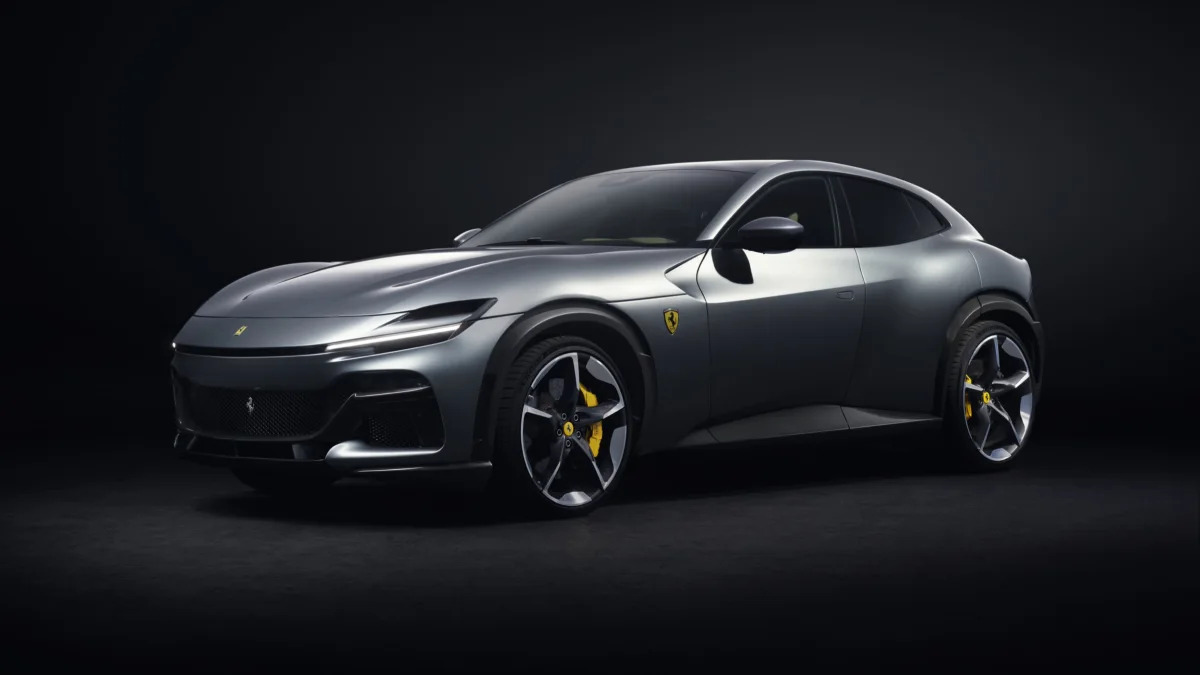MARANELLO, Italy — Surrendering your cellphone is hard enough under any circumstance, let alone when you’re about to lay eyes on Ferrari’s long-awaited, first-ever SUV — which, incidentally, Ferrari absolutely refuses to call an SUV. Welcome to the world of so-called black box previews, where a journalist’s impressions are limited by his or her firsthand powers of observation.
In the curious case of the Ferrari Purosangue, we’re looking back at 75 years of both flirting with, and resisting, possibilities that would eventually become the brand’s first-ever four-door, four-seat car. Though the prancing horse has long been associated with relentlessly focused race cars, supercars and hypercars, Ferrari has also straddled the line with a smaller selection of more GT-like 2+2s. Enzo himself enjoyed driving a four-seater of his creation, and in fact considered a four-door concept by Pininfarina in the 1980s before it was eventually shelved.
Enter modern day, and the Purosangue before us marks a major turning point for the Maranello brand. Liberated from its red satin cover, the new model looks like nothing before it, despite the vaguely 296 GTB-ish front end and somewhat Roma-like taillamps. It’s a handsomely styled car that Ferrari brass say was designed with a keen eye toward the wind tunnel, though the company does not release aerodynamic drag figures for their GT models. Regardless, Purosangue comes across as more subtle and distinctive than the spy shots might have led you to believe, with flowing lines combined with novel features like an aerobridge on the hood similar to that of the F12Berlinetta. In this case, however, the feature is designed to reduce drag, not create downforce. Some could argue that it resembles the layout of the Ford Mustang Mach-E GT, with its long, arching roofline, large wheel wells, cinched rocker panels and tapered rear deck. But there’s much more going on here design-wise, from the delicately tapered nose to the clever “floating” wheel arches to the complex curves of the rear haunches. The shape looks deceptively compact, until you consider those seemingly small wheels are actually 22- and 23-inch hoops tucked within those fenders.

Interior volume is maximized thanks to relatively short overhangs, as is ease of entry due to suicide-style rear doors that open with an aperture of 79 degrees, via a power-actuated mechanism. The easy access is important, especially since there’s not a whole lot of legroom for the two rear occupants: I’m 5’11”, and after getting comfortable in the driver seat then switching to the rear perch, I found that there was some space, but not a whole lot, for me to straighten my legs. However, there’s generous headroom that helps make the interior feel more vertically airy and spacious.
The cabin is a combination of well-appointed, high-tech and modern, with individual rear bucket seats that echo the form factor of the front seats. Though the leather upholstery has an upscale feel, there are also contemporary touches like a more technical Alcantara carpet trim that also happens to be bulletproof. Symmetry rules the interior design, with a mirror-like dashboard that sculpts its form around the driver’s digital instrument cluster and a passenger screen that’s larger than what you’ll find in Ferrari sports cars. Though the power-operated rear doors feel fancy (and minimalist, thanks to their frameless design), there’s also an impression of functionality to the whole endeavor — but not too functional, as the sportiness of the seats is backed up by the relatively compact 16.7 cubic-foot trunk. At least the rear seats fold down for added storage. Discreetly tucked between the rear seats is a flip-up leather cover for two cupholders; other unusual touches include a small multimedia control dial with grooved edges that raises or recesses at the touch of a button, and numerous shallow storage compartments that taper along lengthy sections of the interior.



Rather than incorporate a hybrid or full-EV drivetrain, Purosangue features a delightfully old-school propulsion system: a naturally aspirated 6.5-liter V12 producing 715 horsepower and 528 pound-feet of torque. Revised valvetrain, induction and exhaust systems enable the powertrain to realize 80% of its torque from 2,100 rpm. A dry sump system allows it to sit lower to the ground, and its front-mid-engine configuration and rear transaxle achieves an impressive front/rear weight distribution of 49/51. An all-new platform utilizes a stiffer, lighter structure that enables 30% more torsional stiffness than the late, great GTC4Lusso, yielding a dry weight of 4,482 pounds. Mated to an eight-speed dual-clutch gearbox, the engine drives all four wheels and should go like stink, with a claimed 0-62-mph time of 3.3 seconds and a top speed in excess of 192 mph. Like the now defunct GTC4Lusso, an all-wheel-drive system works up to fourth gear at 125 mph before disengaging.
Subtly sleek, curvaceous and delicately proportioned, the Ferrari Purosangue exceeds expectations in the flesh. In a way it ought to, with a starting sticker price of €390,000, or around $400,000. More important, this difficult-to-classify four-door breaks a new mold for Ferrari, one that we’re told is the product of many customer requests. No doubt there will be haters, in much the same way Porsche fanatics distrusted the Cayenne when it debuted. As it turns out, the folks in Zuffenhausen couldn’t have orchestrated a better anchor for the business, as sport utes now command over half of company sales, a phenomenon that’s being encountered by countless other ultraluxury carmakers.
In the here and now, the Purosangue presents a strong case for itself thanks to its stringent design philosophy and adherence to brand principles. It’s so focused on performance that it only offers two rear seats, and buyers couldn’t get a tow hitch attached to the tail if they wanted one. While it might be tempting to say that Enzo Ferrari would not approve of a Ferrari SUV or crossover, it’s hard to argue with the Purosangue’s execution. If this high-waisted four-seater drives half as well as we suspect it does, Ferrari should be onto a winner.










Sign in to post
Please sign in to leave a comment.
Continue